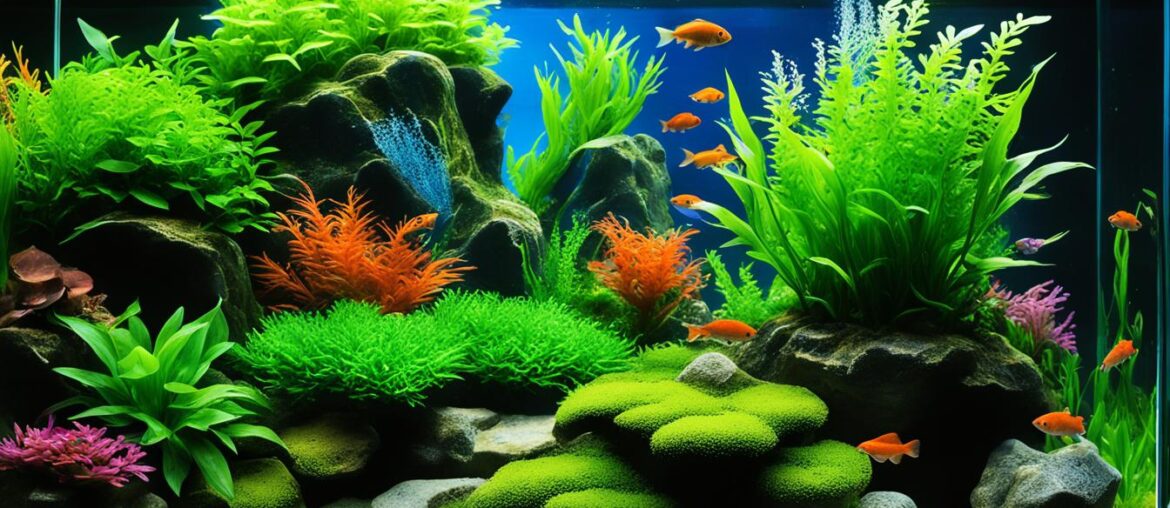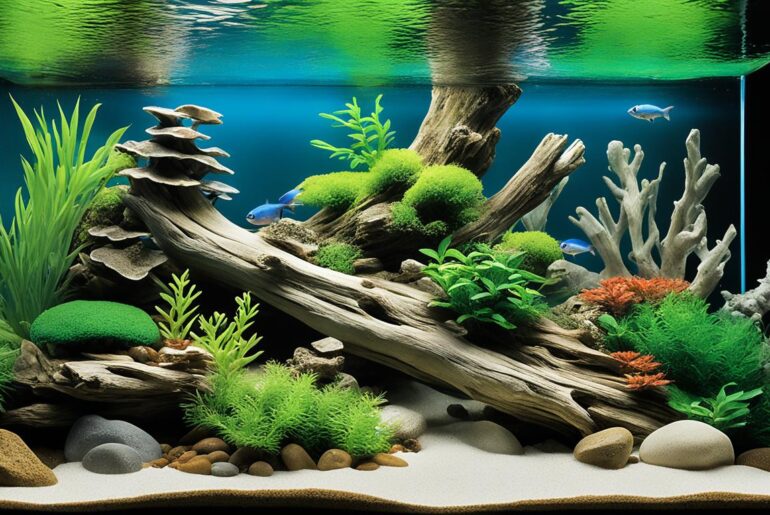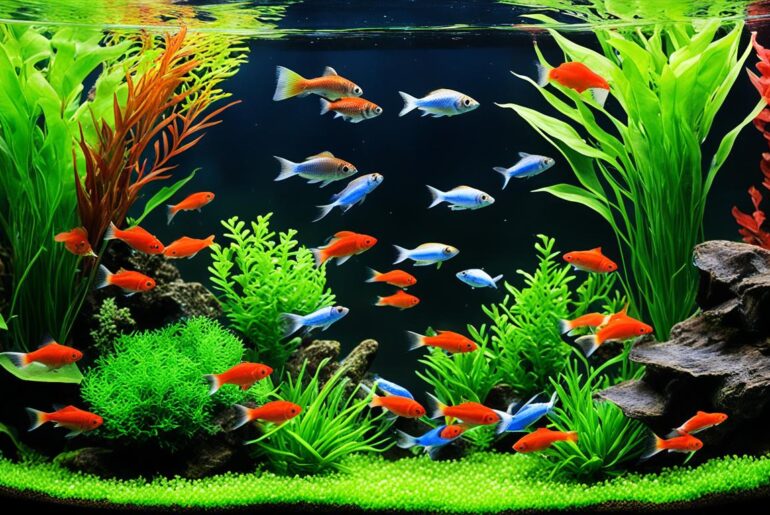Imagine coming home after a long, stressful day, and just as you step through the door, a sense of calm washes over you. The soothing sound of water, the vibrant colors dancing in the tank, and the mesmerizing movement of the fish instantly transport you to a peaceful oasis. This is the power of a freshwater aquarium.
As an avid aquarium enthusiast, I’ve experienced firsthand the joy and tranquility that comes with caring for these underwater wonders. But it’s not just about the beauty and relaxation. Maintaining a healthy freshwater aquarium is essential for the well-being of the fish and the longevity of the ecosystem.
Through years of research and hands-on experience, I have gathered valuable insights and strategies to help you create a thriving freshwater tank. In this ultimate guide, I will share everything you need to know about freshwater aquarium health and disease prevention, from proper maintenance practices to healthy aquarium strategies.
Whether you’re just starting your journey into the world of aquarium keeping or you’re a seasoned enthusiast looking to enhance your knowledge, this guide will provide you with the tools and information you need to build and maintain a vibrant and disease-free freshwater aquarium.
So, let’s dive in and explore the fascinating realm of freshwater aquariums!
Key Takeaways:
- Proper maintenance practices are essential for the health of your freshwater aquarium.
- Each species of fish has specific needs and requirements that should be considered.
- Including floating plants in your aquarium provides hiding places for shy fish and creates low-light conditions.
- Regular water changes and substrate selection are crucial for maintaining a healthy aquatic environment.
- The balance of macronutrients and micronutrients in the water is crucial for the health of aquarium plants.
Choosing Your Aquarium
When it comes to choosing an aquarium, there are several factors that you should consider. Whether you’re a beginner or an experienced hobbyist, finding the right aquarium is crucial for the well-being of your fish and plants. Let’s explore some key factors to keep in mind.
Freshwater vs. Saltwater
One of the first decisions you’ll need to make is whether you want a freshwater or saltwater aquarium. Freshwater aquariums are generally easier to maintain and have a wider variety of fish species and plants available. They are also more cost-effective compared to saltwater aquariums. So, if you’re new to the hobby or on a budget, a freshwater aquarium might be the way to go.
Size Matters
The size of your aquarium is another important consideration. Large aquariums offer more space for a greater variety and number of fish. They also provide more room for natural swimming behaviors and the opportunity to create diverse aquatic landscapes. However, large aquariums can be more challenging to maintain and require more space in your home. On the other hand, small aquariums are suitable for beginners or those with limited space and budget. They offer a more manageable setup and require less maintenance.
Other Factors to Consider
In addition to the type and size of the aquarium, there are other factors you should take into account:
- Available Space: Consider the area where you plan to place your aquarium. Make sure you have enough space for the size of the aquarium and any additional equipment, such as a stand or filtration system.
- Budget: Set a budget for your aquarium setup, including the tank, equipment, and decorations. Remember to factor in ongoing costs, such as fish food, water treatments, and electricity.
- Level of Complexity: Think about your level of experience and the amount of time you’re willing to invest in maintaining your aquarium. Some setups require more advanced filtration systems, lighting, and water chemistry monitoring.
By considering these factors, you’ll be able to choose an aquarium that suits your needs, preferences, and level of commitment. Remember to take your time and do thorough research before making a final decision.
Setting Up Your Aquarium
Properly setting up your aquarium is essential for creating an optimal environment that promotes the health and well-being of your aquatic pets. Follow these steps to ensure a successful setup.
Gather and Prepare the Equipment
Before you start setting up your aquarium, gather all the necessary equipment. This includes the tank, filter, heater, thermometer, substrate, decorations, and lighting. Ensure that everything is clean and in good working condition.
“A well-prepared setup is the foundation of a thriving aquarium.”
– Expert Aquarist
Cleaning the Aquarium
Thoroughly clean the aquarium to remove any dust, residue, or contaminants that could harm your fish. Rinse the tank, filter, and decorations with clean water. Avoid using soap or cleaning agents, as they can be toxic to your aquatic pets.
Positioning the Aquarium
Choose a suitable location for your aquarium, considering factors such as stability, visibility, and accessibility. Ensure that it is away from direct sunlight and drafts, as these can cause fluctuations in temperature and promote algae growth. Additionally, make sure the surface can support the weight of the tank when filled with water.
Filling the Aquarium
When filling your aquarium with water, use dechlorinated water to protect your fish from harmful chemicals. Fill the tank slowly to avoid disturbing the substrate and decorations. Aim to maintain a consistent water level that allows your fish to swim comfortably.
Establishing the Biological Filter
The biological filter is crucial for maintaining water quality and creating a stable ecosystem. Allow the filter to run for at least 24 hours before adding any fish. This allows beneficial bacteria to colonize and break down harmful substances, such as ammonia and nitrite, ensuring a safe environment for your fish.
Follow these steps, and you’ll be on your way to setting up a thriving aquarium for your aquatic pets!
“A well-prepared setup is the foundation of a thriving aquarium.”
– Expert Aquarist

Aquarium Setup Checklist
| Step | Description |
|---|---|
| 1 | Gather and Prepare Equipment |
| 2 | Clean the Aquarium |
| 3 | Position the Aquarium |
| 4 | Fill the Aquarium with Dechlorinated Water |
| 5 | Establish the Biological Filter |
Selecting Fish for Your Aquarium
Choosing the right fish for your aquarium is a crucial decision that impacts the overall health and harmony of your underwater community. When selecting fish, it’s important to consider their individual characteristics and requirements to ensure compatibility with other tank inhabitants.
Let’s explore the different types of fish you may encounter:
Community Fish
Community fish are peaceful species that generally get along well with others. They are an excellent choice for beginner aquarium enthusiasts or those looking to create a diverse and harmonious environment. Some popular community fish include:
- Tetras
- Guppies
- Mollies
- Platies
- Neon Tetras
Aggressive Species
Aggressive fish tend to be territorial and may exhibit dominant behavior towards other tank mates. It’s important to carefully consider their compatibility and provide ample space to avoid unnecessary conflicts. Examples of aggressive species include:
- Oscars
- Cichlids
- Jack Dempseys
- Betta Fish
- Siamese Fighting Fish
Peaceful Inhabitants
Peaceful inhabitants, also known as bottom dwellers or tank cleaners, play a key role in maintaining a clean and balanced aquarium ecosystem. They are typically scavengers that help control algae and consume leftover food. Some peaceful inhabitants include:
- Corydoras Catfish
- Otocinclus Catfish
- Mystery Snails
- Ghost Shrimp
- Chinese Algae Eaters
When selecting fish for your aquarium, consider the following factors:
- Temperament: Assess the temperament of each fish species and ensure they are compatible with other tank inhabitants.
- Size: Take into account the adult size of each fish species to ensure they have enough space to grow and thrive.
- Preferred Water Conditions: Research the specific water parameters required by each fish species, including temperature, pH level, and water hardness.
Remember, proper research and gradual introduction of new fish are essential for maintaining a balanced and vibrant aquarium ecosystem. Regular observation and monitoring of fish behavior will help you identify any potential compatibility issues and address them promptly.
| Fish Species | Temperament | Size | Preferred Water Conditions |
|---|---|---|---|
| Tetras | Peaceful | Small | Neutral pH, 72-80°F |
| Guppies | Peaceful | Small | Neutral pH, 72-82°F |
| Mollies | Peaceful | Small to Medium | Slightly alkaline pH, 75-82°F |
| Platies | Peaceful | Small | Neutral pH, 70-82°F |
| Neon Tetras | Peaceful | Small | Neutral pH, 70-81°F |
| Oscars | Aggressive | Large | Neutral pH, 74-81°F |
| Cichlids | Aggressive | Various Sizes | Variable pH, 72-82°F |
| Jack Dempseys | Aggressive | Medium to Large | Neutral pH, 72-86°F |
| Betta Fish | Aggressive | Small | Neutral pH, 75-82°F |
| Siamese Fighting Fish | Aggressive | Small | Neutral pH, 75-82°F |
| Corydoras Catfish | Peaceful | Small | Neutral pH, 72-80°F |
| Otocinclus Catfish | Peaceful | Small | Neutral pH, 72-82°F |
| Mystery Snails | Peaceful | Small to Medium | Neutral pH, 68-82°F |
| Ghost Shrimp | Peaceful | Small | Neutral pH, 70-82°F |
| Chinese Algae Eaters | Peaceful | Medium | Variable pH, 75-82°F |
Aquarium Plants
Including aquarium plants in your freshwater aquarium offers several benefits. They provide oxygenation, enhance aesthetics, and serve as hiding spots for fish. Choosing the right plants depends on the lighting conditions and your willingness to care for them. Easier to care for plants are suitable for beginners, while more advanced care plants require more time and effort.
Benefits of Aquarium Plants
- Enhance oxygenation in the water
- Adds beauty and aesthetics
- Provide shelter and hiding spots for fish
Choosing the Right Plants
When selecting aquarium plants, consider the lighting conditions in your tank. Different plants have varying light requirements, such as low light, moderate light, or high light. Assess your willingness to care for the plants, as some require more maintenance than others. Beginners may prefer easy-to-care-for plants, while experienced hobbyists can enjoy the challenge of maintaining advanced care plants.
Popular Aquarium Plants
| Plant Name | Lighting Requirement | Difficulty Level |
|---|---|---|
| Anubias | Low to moderate light | Easy |
| Java Fern | Low to moderate light | Easy |
| Cryptocoryne | Low to moderate light | Easy |
| Dwarf Hairgrass | High light | Moderate |
| Rotala | High light | Difficult |

Adding aquarium plants not only enhances the appearance of your freshwater aquarium, but it also provides a range of benefits for your fish. The plants help to oxygenate the water, creating a healthier and more natural environment for your aquatic pets. Additionally, the plants act as hiding spots, reducing stress among fish and promoting a more harmonious community. By considering the lighting requirements and your own commitment to plant care, you can select the right aquarium plants to create a beautiful and thriving underwater ecosystem.
Aquarium Maintenance
Regular maintenance plays a crucial role in ensuring the health and longevity of your freshwater aquarium. By following a few simple strategies, you can maintain a healthy environment for your fish and promote their overall well-being.
Water Changes
One of the key tasks in aquarium maintenance is conducting regular water changes. This helps remove accumulated waste, toxins, and excess nutrients from the water. Aim to change about 25% of the aquarium water every two weeks, using a siphon or a gravel vacuum to clean the substrate while siphoning out the water. Make sure to treat the new water with a water conditioner to remove chlorine and chloramines before adding it to the aquarium.
Filtration Equipment Maintenance
Proper maintenance of your filtration equipment is essential for the efficient removal of waste and toxins from the water. Clean the filter media regularly according to the manufacturer’s instructions, typically once a month. Avoid replacing all the filter media at once, as it may disrupt the beneficial bacteria colonies that help maintain water quality. Instead, rinse the filter media in the aquarium water you removed during water changes. This helps preserve the biological filtration system.
Controlling Algae Growth
Algae growth is a common issue in freshwater aquariums. To control algae, take several preventive measures. Avoid overfeeding your fish, as excess food can contribute to algae growth. Keep the aquarium away from direct sunlight, as it can stimulate algae growth. Maintain a consistent lighting schedule, typically 8-10 hours of light per day. Consider using an algae scraper or a magnetic algae cleaner to remove any algae buildup from the aquarium walls and decorations.
Water Quality Monitoring
Regular monitoring of water quality parameters is essential for the health of your aquarium. Test the water regularly for pH, ammonia, nitrite, and nitrate levels to ensure they remain within the appropriate ranges for your fish species. Keep a log of your test results to track any trends or changes in water quality over time. This will help you identify and address any issues promptly.
Aquarium Maintenance Checklist:
| Task | Frequency |
|---|---|
| Water Changes | Every two weeks (25% water change) |
| Filtration Equipment Maintenance | Once a month (clean filter media) |
| Controlling Algae Growth | Ongoing (as needed) |
| Water Quality Monitoring | Weekly (test pH, ammonia, nitrite, nitrate) |
By following these aquarium maintenance practices, you can create a clean and healthy freshwater environment for your fish to thrive and enjoy.

Fish Health and Nutrition
Ensuring the health and well-being of your fish is essential for maintaining a thriving aquarium. Proper feeding and maintaining optimal water conditions are key factors in promoting fish health and preventing illnesses. By understanding the specific dietary needs of different fish species, avoiding overfeeding, and providing suitable heat and lighting, you can create a healthy environment for your aquatic pets.
Feeding Schedules and Dietary Needs
Establishing a regular feeding schedule is crucial for maintaining fish health. Each species of fish has its own dietary requirements, including the type and amount of food they need. It is important to research and understand the specific needs of the fish in your aquarium to ensure they receive the proper nutrition.
Overfeeding can lead to various health problems, such as obesity, poor water quality, and digestive issues. It is recommended to feed fish small, frequent meals rather than one large feeding. This helps mimic their natural feeding patterns and promotes better digestion.
| Fish Species | Dietary Needs |
|---|---|
| Guppies | High-quality flake food, supplemented with live or frozen brine shrimp or daphnia. |
| Betta Fish | Pellets specially formulated for bettas, with occasional treats of bloodworms or brine shrimp. |
| Tetras | Small, high-quality pellets or flakes, supplemented with live or frozen daphnia or mosquito larvae. |
Remember to feed your fish an amount they can consume within a few minutes to prevent overfeeding and excess food waste, which can lead to water quality issues.
Optimal Water Conditions
Maintaining proper heat and light levels in your aquarium is crucial for fish health. Different fish species have different temperature requirements, so it is important to research and provide the appropriate temperature range for your fish.
Lighting also plays a significant role in the well-being of your fish and the growth of aquarium plants. Most fish species require a regular light-dark cycle, simulating their natural environment. It is recommended to provide approximately 8-12 hours of light per day.
Regularly monitoring water parameters such as pH, ammonia, nitrite, and nitrate levels is essential for fish health and disease prevention. Sudden fluctuations or imbalances in these parameters can stress fish and make them more susceptible to illnesses.
Observation and Disease Prevention
Regular observation of your fish is important for identifying early signs of illness or stress. If a fish appears lethargic, loses appetite, displays abnormal swimming behavior, or exhibits physical symptoms like discoloration or fin rot, it may indicate an underlying health issue.
An essential aspect of fish health and disease prevention is quarantine. By quarantining new fish for a period of time, you can observe them for any signs of illness before introducing them into the main aquarium. This helps prevent the spread of diseases to other fish in the tank.
Apart from visual observation, understanding common fish diseases and their symptoms can help you take timely action. Some common fish diseases include fungal infections, bacterial infections, and parasitic infestations.
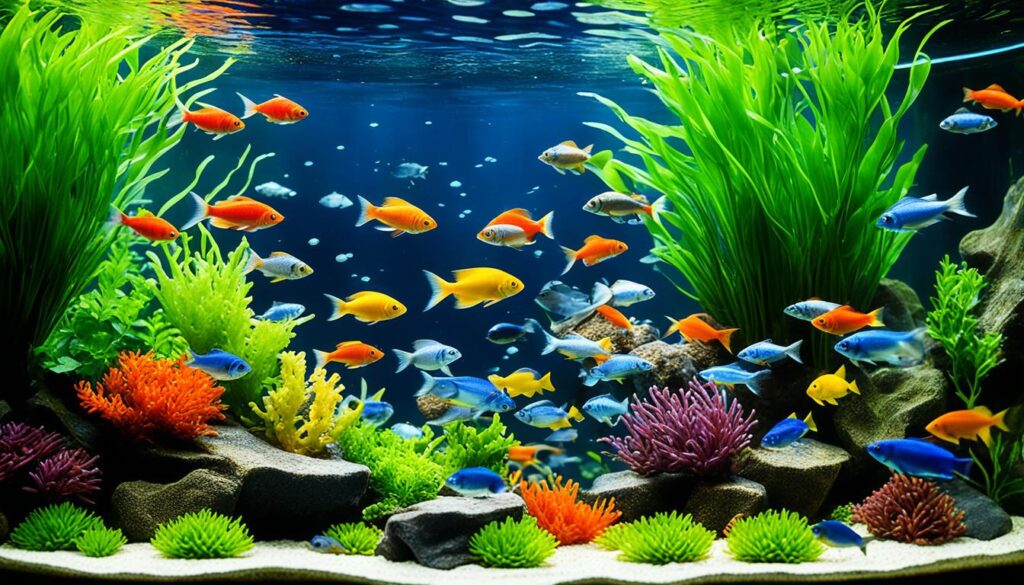
Regular feeding, maintaining optimal water conditions, and vigilant observation are key to ensuring the health and well-being of your fish. By providing them with proper nutrition, suitable heat and lighting, and a stress-free environment, you can help prevent illnesses and cultivate a thriving aquarium ecosystem.
Aquarium Equipment
Choosing the right aquarium equipment is crucial for maintaining a healthy and thriving aquatic environment. Here are the key components you need to consider:
Filtration Systems
A proper filtration system is essential for keeping the water clean and free from harmful substances. There are three main types of filtration systems:
- Mechanical Filters: These remove physical debris and particles from the water.
- Chemical Filters: These use activated carbon or other media to remove impurities and toxins.
- Biological Filters: These promote the growth of beneficial bacteria that break down harmful substances, such as ammonia and nitrite.
Heaters
Most freshwater fish species require a specific temperature range to thrive. A reliable and adjustable aquarium heater ensures a stable and suitable water temperature. It’s important to choose a heater that is appropriate for the size of your aquarium.
Lighting
Lighting is crucial for the health and growth of aquarium plants. LED lights are energy-efficient and provide the necessary spectrum for photosynthesis. Consider the lighting requirements of your plants and choose a suitable lighting system accordingly.
Other Necessary Equipment
In addition to filtration systems, heaters, and lighting, you may need other equipment for your aquarium, such as:
- Air pumps and airstones for oxygenation.
- Aquarium gravel or substrate for a natural and aesthetically pleasing look.
- Water test kits to monitor water parameters and ensure optimal conditions.
- Nets and aquarium cleaning tools for maintenance purposes.
Remember to regularly inspect and clean your equipment to ensure its proper functioning and longevity. Clean and well-maintained equipment contributes to a healthy and thriving aquarium ecosystem.
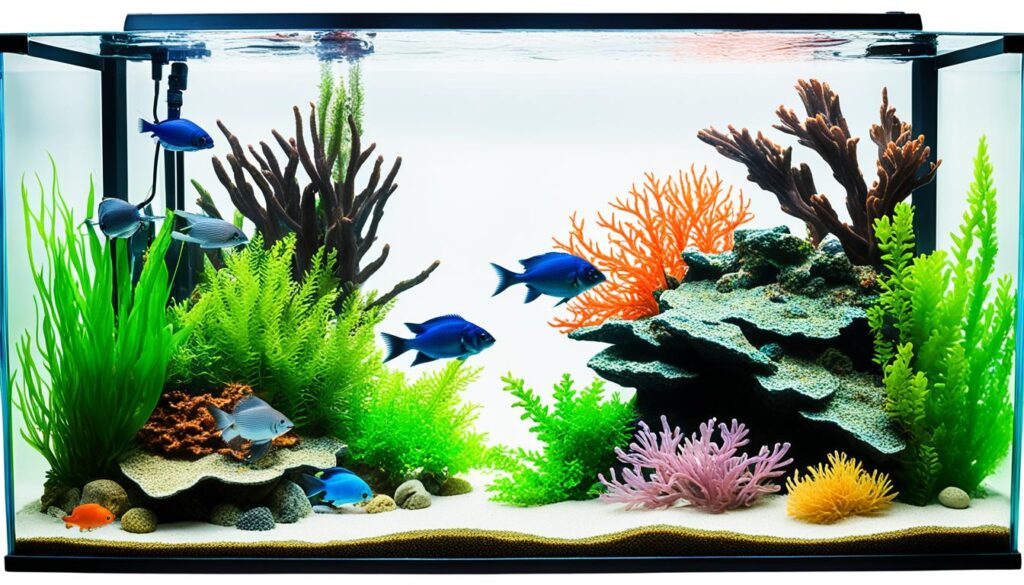
| Equipment | Description |
|---|---|
| Filtration Systems | Remove debris, impurities, and toxins from the water |
| Heaters | Maintain a stable and suitable water temperature |
| Lighting | Promote the growth of aquarium plants and enhance visibility |
| Other Necessary Equipment | Air pumps, substrates, water test kits, nets, etc. |
Conclusion
Maintaining the health of your freshwater aquarium is crucial to ensuring the well-being of your aquatic pets and creating a beautiful underwater environment. By following the guidelines and implementing the strategies outlined in this guide, you can establish a thriving aquatic ecosystem while preventing common fish diseases.
Proper setup is the foundation of a healthy aquarium. Pay attention to the specific needs of your fish and plants, including their habitat, food requirements, and water temperature. Take the time to choose the right aquarium size that suits your space and budget, ensuring that your fish have ample room to swim and thrive.
Regular maintenance is key to preserving the health of your freshwater aquarium. Perform routine water changes and clean the filtration equipment to maintain optimum water quality. Control algae growth and monitor water parameters to create a balanced and stable environment for your fish and plants.
With proper care and attention, your freshwater aquarium can provide years of enjoyment and serve as a source of tranquility in your home. Remember to feed your fish according to their dietary needs, observe for any signs of illness, and promptly address any health issues that may arise. By implementing these aquatic pet care tips, you can create a vibrant and thriving freshwater aquarium.
FAQ
What are the health benefits of keeping a freshwater aquarium?
Keeping a freshwater aquarium has been shown to reduce blood pressure, promote relaxation, and improve sleep.
Where should I place my aquarium?
Choose a location away from direct sunlight and drafts.
What maintenance practices are essential for the health of my freshwater tank?
Regular water changes and proper substrate selection are essential for the health of the fish.
What factors should I consider when choosing an aquarium?
Factors such as available space, budget, and level of complexity should be considered when choosing an aquarium.
How do I properly set up my aquarium?
Proper setup involves unpacking and installing the necessary equipment, cleaning the aquarium, and filling it with dechlorinated water.
How can I select the right fish for my aquarium?
Consider compatibility based on factors such as temperament, size, and preferred water conditions when choosing fish.
What are the benefits of including aquarium plants in my freshwater tank?
Aquarium plants provide oxygenation, enhance aesthetics, and serve as hiding spots for fish.
How often should I perform aquarium maintenance?
Regular maintenance tasks include water changes, maintaining filtration equipment, controlling algae growth, and monitoring water quality.
What should I consider when it comes to fish health and nutrition?
Proper feeding schedules, maintaining optimal water conditions, and regular observation are important for fish health and nutrition.
What equipment do I need for my freshwater aquarium?
Necessary equipment includes filtration systems, heaters, lighting, and regular cleaning and inspection to ensure proper functioning.
